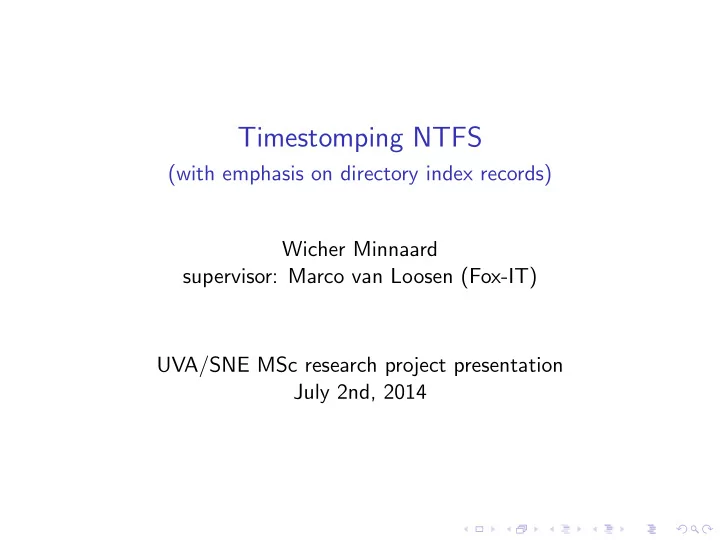

Timestomping NTFS (with emphasis on directory index records) Wicher Minnaard supervisor: Marco van Loosen (Fox-IT) UVA/SNE MSc research project presentation July 2nd, 2014
Research question (1) What forms of NTFS timestamp tampering can be detected by inspecting NTFS structures?
Timestamps on NTFS (1) MACB timestamps: ◮ M odified 1 ◮ A ccessed 2 ◮ C hanged 3 ◮ B irth 4 1 mOdified - cOntents 2 updates turned of by default in recent Windows versions 3 chAnged - metAdata 4 but what does that mean, anyway
Timestamps on NTFS (2) In the Master File Table entries: ◮ SI - STANDARD INFORMATION attribute. User-modifiable through SetFileInformationByHandle and ZwSetInformationFile routines. ◮ FN - FILE NAME attribute. Files can have multiple of these, in different namespaces. They are not exposed to userspace. ◮ Inside directory indices: timestamps reflecting SI timestamps, but embedded inside an FN attribute... Maximum number of timestamps: 4 (MACB) * (1 SI, 3 FN, 3 directory index entries) = 28!
Tampering techniques How does one tamper with timestamps (”timestomping”) ? ◮ Through APIs, as classic timestomp.exe 5 does. Not perfect. ◮ Direct modification of on-disk NTFS structures. Current cream of the crop: later versions of SetMace 6 . 5 James Foster Vinnie Lin, Blackhat 2005 6 Joakim Schicht, 2011-2014
Research question revisited What forms of NTFS timestomping can be detected by inspecting NTFS structures?
Research question revisited What forms of NTFS timestomping can be detected by inspecting NTFS structures? Subquestions: ◮ What is the form, function, and location of all these timestamps? How do they relate to each other? ◮ What timestomping techniques are available to modify each timestamp? ◮ What inconsistencies (if any) do the techniques introduce?
Timestomping detection
Timestomping detection subtlety is key!
Timestomping detection subtlety is key! Common slip-up: Forgetting about the 100ns timestamp resolution: 2014-01-01 12:12:34.000000
Timestomping detection subtlety is key! Generally: look for inconsistencies
Timestomping: Inconsistencies ◮ Causal relationships ( happened-before ): allocators, sequence numbers. Willassen, 2008. ◮ Deriving past operations from the NTFS journal. Cho, 2012. ◮ Explicit second source of timestamps: directory index entries in B-tree slack (INDEX ALLOCATION): INDXParse.py , Ballenthin, 2011-2014.
Parsing the INDEX ROOT attribute With the Hachoir framework: .
Growing a directory index
Growing a directory index
Growing a directory index
Growing a directory index
Growing a directory index
Growing a directory index
Growing a directory index
Carving root index entries from MFT slack
SetMACE directory indices
Fingerprinting timestamp relations (1) What about self-inconsistencies in time stamps?
Fingerprinting timestamp relations (1) What about self-inconsistencies in time stamps? As the FILE NAME timestamps are a snapshot of some earlier state of the STANDARD INFORMATION timestamps... the former should always be less or equal to the latter, right?
Fingerprinting timestamp relations (1) What about self-inconsistencies in time stamps? As the FILE NAME timestamps are a snapshot of some earlier state of the STANDARD INFORMATION timestamps... the former should always be less or equal to the latter, right?
Fingerprinting timestamp relations (2) An example fingerprint: . sia = sib < sim < fna = fnb = fnc = fnm < sic . Total number of possible configurations 7 : 7 Sum of binomial coefficients
Wildtype timestamps A skewed, but long-tailed distribution. Example: Cumulative distribution of timestamp fingerprints of EXE files on 1.5 years old Windows 7 system. . BLA: Combine with NSRL whitelists, use as ranking mechanism
Conclusions What forms of NTFS timestamp tampering can be detected by inspecting NTFS structures? → It depends. When it comes to finding inconsistencies; ◮ Index records may be overlooked by direct-access timestomping tools. However, Windows helpfully repairs resulting inconsistencies. 8 ◮ Old index records may be found in slack space. ◮ Wildtype timestamp configurations do not follow intuitions. Anomaly detection based on wildtype timestamp configuration frequencies may be of some use in the ranking phase. 8 Next step: Extended consistency checker, for instance, cross-check each of the FN attributes in the multiple namespaces and the directory indices
Recommend
More recommend